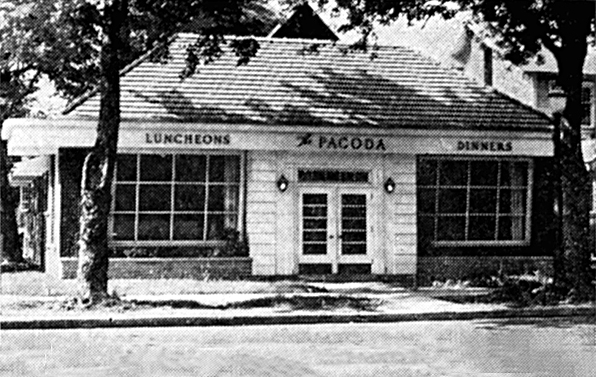In 1934 Ida M. Gallagher opened a 12-seat restaurant at 1328 East Michigan Avenue in Lansing, Michigan, with the idea of offering Chinese-style dishes to people interested in something slightly more exotic than the standard fare offered by other tea rooms in the city. She named it the Pagoda Restaurant, and its distinctive roof with turned-up corners and ornamental sign above the front entrance brought in plenty of curiosity-seekers. The food, which was better than anything else in the neighborhood, brought them back, as did the alluring variety of baked goods—including Danish pastries, buttermilk nut bread, cinnamon rolls, coffee cakes, lunch rolls, and vanilla sticks (almond cookies)—that were sold from a counter in the restaurant.
Business was so good from the outset that by 1941 Gallagher was able to completely remodel and redecorate her restaurant, complete with new kitchen equipment. Along the way she’d added some classic American dishes to the Pagoda’s menu, and her name—“Mrs. Gallagher”—trumped the restaurant’s in the ads she placed in the Lansing State Journal. She’d also taken on a partner: Frank S. Smith, a furniture dealer in Evart, Michigan,
In 1950 Gallagher bought an old house at 1824 East Michigan Avenue, some six blocks to the blocks, with the idea of expanding it on all four sides, thus incorporating its brick walls into the interior, and turning it into the new home of the Pagoda. She and Smith sank more than $100,000 into renovations, fixtures, furnishings, and equipment. The dining rooms on the main floor could seat more 100 patrons, and the Cedar Room, in the basement, could handle another 100 for banquets and other special occasions. Hanging everywhere, it seemed, were hand-colored stone lithographs of birds by John Gould, a famous English ornithologist and contemporary of John James Audubon, that Smith had recently acquired from the estate of Charles J. Davis, a onetime circus manager, former mayor of Lansing, and prolific amateur taxidermist. (Smith also acquired Davis’s collection of thousands of mounted animals and birds and used it to establish a tourist attraction in Paris, Michigan.)
Eugene J. Wiegers, a talented chef, was in charge of the Pagoda’s kitchen, and in 1956 a reporter for the Lansing State Journal got him to disclose the secret behind his “Chuck Wagon Roast Prime Ribs of Beef,” one of the most restaurant’s most popular menu items. “The primary secret is the size,” Wiegers explained. “It’s difficult to get the flavor and degree of rare doneness needed in a prime rib unless it comes close to 17 to 20 pounds. That’s why the attempt of the young homemaker to fix a roast like a hotel or restaurant serves ends in frustration.”
Then came the recipe, which was presented exactly as follows: “Prepare a prime or choice rib weighing 17 to 22 pounds from which shin and [shoulder] blade bone have been removed and the blade area tied. First rub the roast with a garlic clove and then sprinkle generously with salt. Place the rib ‘bark side up’ in a flat shallow pain. Put in 450-degree oven for 1/2 hour. Reduce heat to 350 degrees and continue roasting for 3 1/2 hours.”
The Pagoda prospered in its new location, and in 1952 Gallagher and Smith took the novel step of adopting a generous profit-sharing plan under which they would get 5 percent of the restaurant’s net profits, with the rest distributed in equal amounts to its 30 or so employees.
In 1959 Smith died at age 67. The following year Gallagher leased the Pagoda to Amel and Ada Dunbar, who had operated the Dunbar Dining Room in Sault Ste. Marie, Michigan. (Gallagher retained ownership of the restaurant and its real estate, including a parking lot on Regent Street.) But things with the Dunbars, who tried to rename the restaurant, didn’t work out, and by 1962 Ida Gallagher was back in charge at the Pagoda. That same year she introduced a service she called “a la mobile dinners,” where customers could phone in orders and have them delivered at no extra charge, and not long after that she turned the operation of the restaurant over to her son, Charles.
The Pagoda Restaurant closed its doors at the end of 1968, and its contents were sold at auction on January 6, 1969. The building was later occupied by a building salon.
Ida Gallagher died in 1980 at age 86; Charles Gallagher died in 1996 at age 80.

Chop Suey
In 1934 Ida M. Gallagher opened the Pagoda Restaurant in Lansing, Michigan, with the idea of offering Chinese-style dishes to people interested in something slightly more exotic than the standard fare offered by other establishments in the city. She almost certainly took some of her inspiration from the success—and promotional activities—of Detroit-based La Choy Food Products, Inc., which since its founding in 1922 had been putting Asian ingredients on millions of American tables. The Pagoda used this recipe—scaled down for home use by Gene Wiegers, its longtime chef—for the Chop Suey it served every day in its dining room. The Pagoda also sold its Chop Suey for takeout by the pint, quart, or gallon and would even deliver it to a customer’s home for “a slight extra charge.”
Ingredients
- 1 1/4 pounds veal, diced
- 1 1/4 pounds pork, diced
- 3 cups chicken broth, or as needed
- 1 1/2 large Pascal celery stalks, diced
- 1 large onion, diced
- 1 large green bell pepper, diced
- 2 1/2 cups canned chop suey vegetables
- 2 tablespoons cornstarch mixed with 4 tablespoons water
Instructions
In a large, wide skillet set over medium-high heat, sear the diced veal and pork until it is browned on all sides, about 10 minutes.
Add enough chicken broth to cover the meat. Simmer 10 minutes.
Add the celery, onion, and green pepper to the skillet and cook until the vegetables are tender.
Add the chop surey vegetables and the cornstarch slurry and simmer until the sauce thickens, about 5 minutes.
Serve immediately over rice.










No Comments